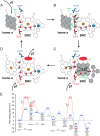Electric fields control water-gated proton transfer in cytochrome c oxidase
- PMID: 36095184
- PMCID: PMC9499568
- DOI: 10.1073/pnas.2207761119
Electric fields control water-gated proton transfer in cytochrome c oxidase
Abstract
Aerobic life is powered by membrane-bound enzymes that catalyze the transfer of electrons to oxygen and protons across a biological membrane. Cytochrome c oxidase (CcO) functions as a terminal electron acceptor in mitochondrial and bacterial respiratory chains, driving cellular respiration and transducing the free energy from O2 reduction into proton pumping. Here we show that CcO creates orientated electric fields around a nonpolar cavity next to the active site, establishing a molecular switch that directs the protons along distinct pathways. By combining large-scale quantum chemical density functional theory (DFT) calculations with hybrid quantum mechanics/molecular mechanics (QM/MM) simulations and atomistic molecular dynamics (MD) explorations, we find that reduction of the electron donor, heme a, leads to dissociation of an arginine (Arg438)-heme a3 D-propionate ion-pair. This ion-pair dissociation creates a strong electric field of up to 1 V Å-1 along a water-mediated proton array leading to a transient proton loading site (PLS) near the active site. Protonation of the PLS triggers the reduction of the active site, which in turn aligns the electric field vectors along a second, "chemical," proton pathway. We find a linear energy relationship of the proton transfer barrier with the electric field strength that explains the effectivity of the gating process. Our mechanism shows distinct similarities to principles also found in other energy-converting enzymes, suggesting that orientated electric fields generally control enzyme catalysis.
Keywords: PCET; QM/MM; bioenergetics; heme-copper oxidases; molecular simulations.
Conflict of interest statement
The authors declare no competing interest.
Figures




References
-
- Kaila V. R. I., Verkhovsky M. I., Wikström M., Proton-coupled electron transfer in cytochrome oxidase. Chem. Rev. 110, 7062–7081 (2010). - PubMed
-
- Kaila V. R. I., Wikström M., Architecture of bacterial respiratory chains. Nat. Rev. Microbiol. 19, 319–330 (2021). - PubMed
-
- Wikström M. K., Proton pump coupled to cytochrome c oxidase in mitochondria. Nature 266, 271–273 (1977). - PubMed
-
- Mitchell P., Coupling of phosphorylation to electron and hydrogen transfer by a chemi-osmotic type of mechanism. Nature 191, 144–148 (1961). - PubMed
Publication types
MeSH terms
Substances
LinkOut - more resources
Full Text Sources

